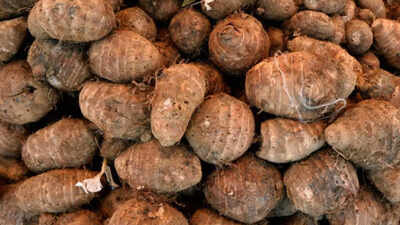Grow Arbi: Ideal Monsoon Veggie for Your Garden

The monsoon season brings a refreshing change. The cool, rainy breeze and lush greenery are delightful. Rainwater nourishes plants, and the scent of wet soil is invigorating. Growing vegetables in your garden during the monsoon can be joyful. However, not all vegetables thrive in this season. Some love the rain, while others struggle with excess water or humidity. Choosing the right vegetable can make your gardening experience rewarding.
Arbi, also known as Colocasia, is one of the easiest vegetables to grow during the monsoon. Imagine enjoying a warm plate of spicy arbi on a rainy day, harvested straight from your garden. Arbi is a low-maintenance, easy-to-grow root vegetable that thrives in the monsoon season.
10 Simple Steps to Grow Arbi in Your Garden
1. Pick the Right Spot
Choose a partly shady area. It should get morning sun and afternoon shade. Arbi likes partial sunlight but not too much heat. Too much heat can dry out the soil quickly.
2. Choose Good Arbi Corms
Pick firm, mold-free corms. It’s even better if they have small shoots. This gives you a head start. Good corms lead to strong plants.
3. Soak the Corms
Soak the corms in water for about 24 hours. This softens the outer layer. It helps the shoot push through and promotes faster growth. Plant the corms the next day.
4. Prepare Rich Soil
Mix garden soil with compost or cow dung. This provides nutrients for the arbi. If using heavy soil, add sand or cocopeat to retain moisture. Break up clumps and remove stones. Soft, fertile soil helps roots develop and corms grow bigger.
5. Plant the Corms
Make holes in the soil about 4-6 inches deep. Place the arbi corms in the holes with the pointed bud side up. Cover with soil. Space the corms at least 1 foot apart to avoid overcrowding and reduce the chance of disease.
6. Water Often
Keep the soil moist, especially in the early stages. Water when the topsoil feels dry. If it rains regularly, you can rely on the rain.
7. Remove Weeds and Add Mulch
Remove weeds by hand. Add mulch like dry leaves or straw. This retains moisture and suppresses weeds.
8. Use Fertilizer
Feed the plants with natural fertilizers like compost or cow dung slurry every 2-3 weeks. This promotes healthy growth.
9. Control Pests
Check for bugs like aphids weekly. Spray neem oil or soapy water if needed. Remove yellow or spotty leaves to prevent fungal spread.
10. Harvest Your Arbi
After 4-5 months, when leaves turn yellow and droop, loosen the soil gently. Lift out the corms without damaging them.



